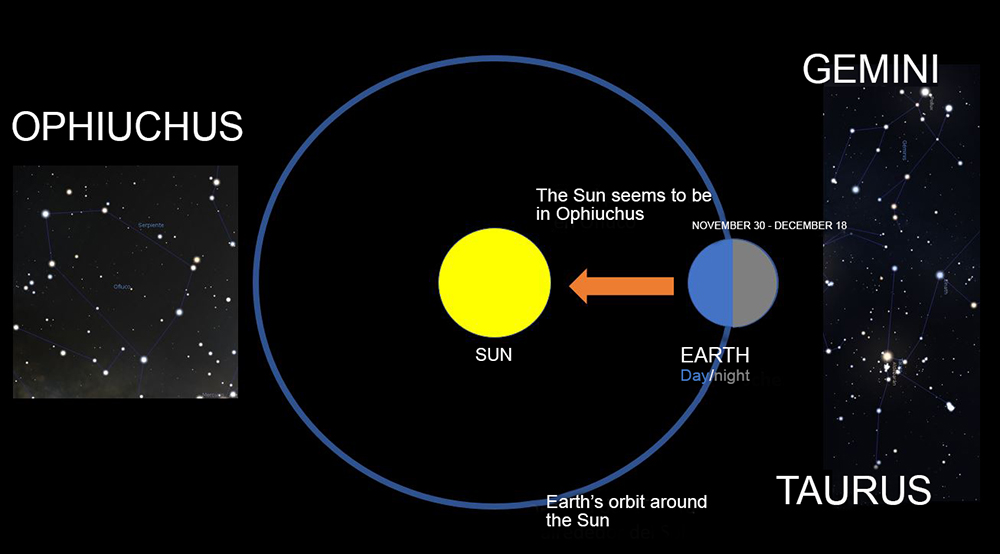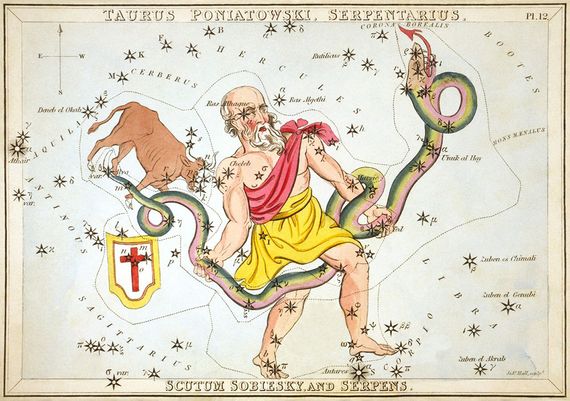The end of autumn is approaching, the time of those born under the sign of Ophiuchus. If we return to the true astronomical roots of the signs of the zodiac, we will see that there are 13 signs, not 12 as the modern horoscope tells us. Reclaiming the forgotten Ophiuchus invites each of us to discover our correct astrological sign and contemplate the spectacular zodiacal constellations that dominate the nights at this time of year.
There is a cadastre that divides the sky into plots that help astronomers to identify the position of the stars, planets and objects in the celestial sphere. We call these plots constellations, which are groups of stars that correspond to the celestial mythology inherited from ancient Greece. Some are more famous than others. You rarely hear about the constellations of Camelopardalis, Sagitta or Boötes; others, however, like Sagittarius, Taurus or Capricorn are much better known.
The latter are the constellations of the zodiac, from the Greek zoodiakos, which means “animal wheel”, although in this group have been placed a scale, a virgin, a pair of twins and a water bearer (Libra, Virgo, Gemini and Aquarius). It is clear that it’s not a relationship with animals that makes them special; these constellations are in a very particular area of the sky, the line along which the Sun advances during the year.

Behind the Sun there are stars, although we cannot see them due to the scattering of light in the Earth’s atmosphere. But if we could see them, we would say that at any time of the year the Sun is “in” some of the zodiacal constellations, since on its annual journey our star always appears to occupy one of these plots. And when we say that someone is a Taurus or a Sagittarius, what we mean is the constellation the Sun was “in” at the moment of their birth: the zodiacal sign is no more than an astronomical reference to the position of the Sun in the sky with respect to the background stars.
The snake charmer
However, these signs are not well calibrated. If we use a celestial planisphere, we will see that between November 30 and December 18, the Sun occupies one of those less famous constellations: Ophiuchus, the serpent bearer or snake charmer. Those born between these dates are, of necessity, the zodiacal sign Ophiuchus.
If we continue to observe the relationship between the position of the Sun and the background of stars, we will see that little coincides with the calendar of signs to which we are accustomed according to horoscopes:
TABLE: Real zodiacal signs, according to the borders between constellations established by the International Astronomical Union (IAU) in 1930
| Sign | Start | End |
| Capricorn | January 19 | February 15 |
| Aquarius | February 16 | March 11 |
| Pisces | March 12 | April 18 |
| Aries | April 19 | May 13 |
| Taurus | May 14 | June 19 |
| Gemini | June 20 | July 20 |
| Cancer | July 21 | August 9 |
| Leo | August 10 | September 15 |
| Virgo | September 16 | October 30 |
| Libra | October 31 | November 22 |
| Scorpio | November 23 | November 29 |
| Ophiuchus | November 30 | December 17 |
| Sagittarius | December 18 | January 18 |
Why does Ophiuchus not appear as a zodiacal constellation in the horoscope? Why don’t the dates coincide? The reason is that 2,500 years ago, when the horoscope originated in ancient Babylon, the Sun crossed through each of the zodiacal constellations on different dates than today, approximately four weeks earlier.
Modern astronomers compute that, nowadays, the Sun enters Aries on April 19 every year like clockwork. But due to the Earth’s axial precession, the Sun is like a clock that lags approximately a quarter of an hour each year. Over many centuries that delay has been accumulating and now the Sun enters Aries almost one month after the date the Babylonians recorded and what the horoscopes indicate.
It could then be said that each person’s horoscope actually corresponds to the sign immediately preceding the one that their modern horoscope marks. But this is not true either. The Sun only spends a week crossing Scorpio, while it spend a month and a half in Virgo; these times of passage are the same now as 2,500 years ago, and differ greatly from the division of one month for each sign of the horoscope arbitrarily established by Babylonian astrologers, who decided to dispense with Ophiuchus and keep a rounder number of 12 signs, as in the 12-month calendar.

Following that calendar allowed Babylonian astrologers to predict when summer was coming or the right time to harvest. The power this granted them in society led them to expand their predictions to include events such as the result of a battle or the personality of an individual based on their sign of the zodiac.
The constellations and its legends
The basis of astrology doesn’t correspond to observations of the real world—it’s an invention that has never dovetailed with the movement of the stars, even at its origin. It has no more use than that of an alternative calendar, with a few months that correspond to mythological figures. What we can do with the zodiac is to observe the shapes of its constellations—which are always seen in the sky on the southern horizon in the northern hemisphere (and on the northern horizon in the southern hemisphere)—and remember their corresponding legends.

During this late autumn and early winter, we can’t recommend trying to observe Ophiuchus—known in mythology as the “snake hunter” and represented as a hero fighting with a reptile—because just when the “ophiuchus” are being born, the Sun passes by ahead of their constellation: being daytime, its stars can’t be seen. But we can observe other impressive constellations:
-
Sagittarius is one of the constellations richest in astronomical objects. A scan with some binoculars reveals nebulae such as the Trifid or the Lagoon and a large number of star clusters.
-
Taurus stands out thanks to its brightest star, Aldebaran, a giant easily identifiable with the naked eye because of its red colour, representing one of the eyes of the animal. On its spine, also without optical assistance, you can see a group of stars: the Pleiades.

Close-up view (rotated) of the nebulae of The Lagoon and Trifid. Credit: Óscar Blanco
-
To the east of Taurus you will find the constellation Gemini, in which two stars of the first magnitude, Castor and Pollux, are identified as the heads of the two twins they represent.
-
A little further east of Gemini you can spot Leo, one of the constellations with the most recognizable shape of the entire catalogue: many civilizations have come to recognize it as a crouching lion of the sky. One of its stars, Regulus, stands out for being one of the brightest in the entire sky.
During these days, shooting stars will appear to radiate from the constellation of Leo, which are produced by the prolific Leonid meteor shower. Famed for its spectacular nature, it is easy to see very bright shooting stars these nights, but in much smaller quantities than other meteor showers like the Perseids in August or the Geminids in December.
The zodiacal constellations will not help us to predict the future, but they are the perfect excuse to get away from the lights of cities and population centres and enjoy a good night of observation.
Comments on this publication